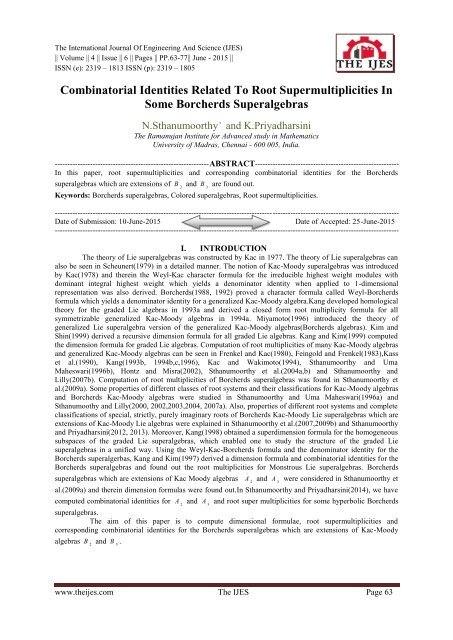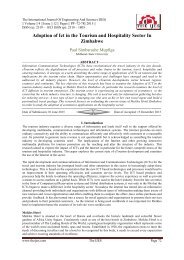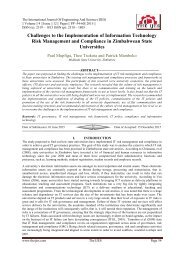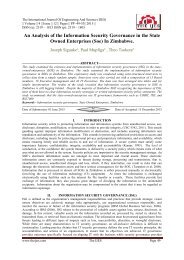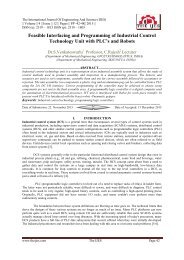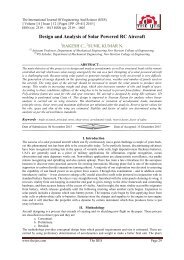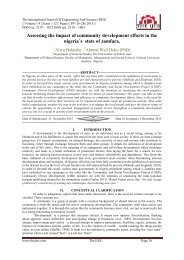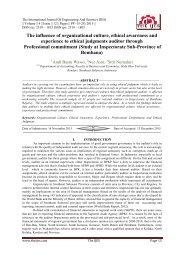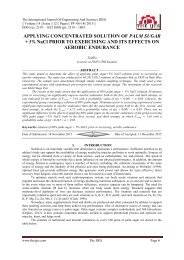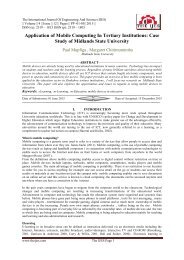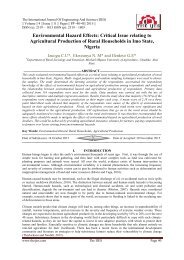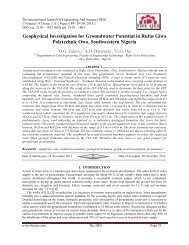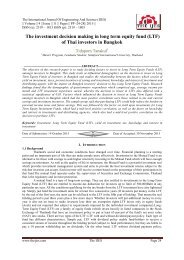Combinatorial Identities Related To Root Supermultiplicities In Some Borcherds Superalgebras
You also want an ePaper? Increase the reach of your titles
YUMPU automatically turns print PDFs into web optimized ePapers that Google loves.
The <strong>In</strong>ternational Journal Of Engineering And Science (IJES)<br />
|| Volume || 4 || Issue || 6 || Pages || PP.63-77|| June - 2015 ||<br />
ISSN (e): 2319 – 1813 ISSN (p): 2319 – 1805<br />
<strong>Combinatorial</strong> <strong>Identities</strong> <strong>Related</strong> <strong>To</strong> <strong>Root</strong> <strong>Supermultiplicities</strong> <strong>In</strong><br />
<strong>Some</strong> <strong>Borcherds</strong> <strong>Superalgebras</strong><br />
N.Sthanumoorthy * and K.Priyadharsini<br />
The Ramanujan <strong>In</strong>stitute for Advanced study in Mathematics<br />
University of Madras, Chennai - 600 005, <strong>In</strong>dia.<br />
-------------------------------------------------------------ABSTRACT---------------------------------------------------------<br />
<strong>In</strong> this paper, root supermultiplicities and corresponding combinatorial identities for the <strong>Borcherds</strong><br />
superalgebras which are extensions of B and B are found out.<br />
2<br />
3<br />
Keywords: <strong>Borcherds</strong> superalgebras, Colored superalgebras, <strong>Root</strong> supermultiplicities.<br />
----------------------------------------------------------------------------------------------------------------------------------------<br />
Date of Submission: 10-June-2015<br />
Date of Accepted: 25-June-2015<br />
----------------------------------------------------------------------------------------------------------------------------------------<br />
I. INTRODUCTION<br />
The theory of Lie superalgebras was constructed by Kac in 1977. The theory of Lie superalgebras can<br />
also be seen in Scheunert(1979) in a detailed manner. The notion of Kac-Moody superalgebras was introduced<br />
by Kac(1978) and therein the Weyl-Kac character formula for the irreducible highest weight modules with<br />
dominant integral highest weight which yields a denominator identity when applied to 1-dimensional<br />
representation was also derived. <strong>Borcherds</strong>(1988, 1992) proved a character formula called Weyl-<strong>Borcherds</strong><br />
formula which yields a denominator identity for a generalized Kac-Moody algebra.Kang developed homological<br />
theory for the graded Lie algebras in 1993a and derived a closed form root multiplicity formula for all<br />
symmetrizable generalized Kac-Moody algebras in 1994a. Miyamoto(1996) introduced the theory of<br />
generalized Lie superalgebra version of the generalized Kac-Moody algebras(<strong>Borcherds</strong> algebras). Kim and<br />
Shin(1999) derived a recursive dimension formula for all graded Lie algebras. Kang and Kim(1999) computed<br />
the dimension formula for graded Lie algebras. Computation of root multiplicities of many Kac-Moody algebras<br />
and generalized Kac-Moody algebras can be seen in Frenkel and Kac(1980), Feingold and Frenkel(1983),Kass<br />
et al.(1990), Kang(1993b, 1994b,c,1996), Kac and Wakimoto(1994), Sthanumoorthy and Uma<br />
Maheswari(1996b), Hontz and Misra(2002), Sthanumoorthy et al.(2004a,b) and Sthanumoorthy and<br />
Lilly(2007b). Computation of root multiplicities of <strong>Borcherds</strong> superalgebras was found in Sthanumoorthy et<br />
al.(2009a). <strong>Some</strong> properties of different classes of root systems and their classifications for Kac-Moody algebras<br />
and <strong>Borcherds</strong> Kac-Moody algebras were studied in Sthanumoorthy and Uma Maheswari(1996a) and<br />
Sthanumoothy and Lilly(2000, 2002,2003,2004, 2007a). Also, properties of different root systems and complete<br />
classifications of special, strictly, purely imaginary roots of <strong>Borcherds</strong> Kac-Moody Lie superalgebras which are<br />
extensions of Kac-Moody Lie algebras were explained in Sthanumoorthy et al.(2007,2009b) and Sthanumoorthy<br />
and Priyadharsini(2012, 2013). Moreover, Kang(1998) obtained a superdimension formula for the homogeneous<br />
subspaces of the graded Lie superalgebras, which enabled one to study the structure of the graded Lie<br />
superalgebras in a unified way. Using the Weyl-Kac-<strong>Borcherds</strong> formula and the denominator identity for the<br />
<strong>Borcherds</strong> superalgerbas, Kang and Kim(1997) derived a dimension formula and combinatorial identities for the<br />
<strong>Borcherds</strong> superalgebras and found out the root multiplicities for Monstrous Lie superalgebras. <strong>Borcherds</strong><br />
superalgebras which are extensions of Kac Moody algebras A and A were considered in Sthanumoorthy et<br />
2<br />
3<br />
al.(2009a) and therein dimension formulas were found out.<strong>In</strong> Sthanumoorthy and Priyadharsini(2014), we have<br />
computed combinatorial identities for A and A and root super multiplicities for some hyperbolic <strong>Borcherds</strong><br />
2<br />
3<br />
superalgebras.<br />
The aim of this paper is to compute dimensional formulae, root supermultiplicities and<br />
corresponding combinatorial identities for the <strong>Borcherds</strong> superalgebras which are extensions of Kac-Moody<br />
algebras B and B .<br />
2<br />
3<br />
www.theijes.com The IJES Page 63
<strong>Combinatorial</strong> <strong>Identities</strong> <strong>Related</strong> <strong>To</strong> <strong>Root</strong>…<br />
II. PRELIMINARIES<br />
<strong>In</strong> this section, we give some basic concepts of <strong>Borcherds</strong> superalgebras as in Kang and Kim (1997).<br />
Definition 2.1: Let I be a countable (possibly infinite) index set. A real square matrix<br />
<strong>Borcherds</strong>-Cartan matrix if it satisfies:<br />
(1) a = 2 or a 0 for all i I ,<br />
ii<br />
ii<br />
(2) a 0 if i j and a Z if a = 2 ,<br />
ij<br />
ij<br />
ii<br />
A<br />
= ( ) is called<br />
a ij<br />
i , j<br />
I<br />
(3) a 0 a = 0<br />
ij<br />
=<br />
ji<br />
We say that an index i is real if a = 2 and imaginary if a 0 . We denote by<br />
I<br />
ii<br />
re<br />
= { i I<br />
| a<br />
ii<br />
=<br />
2},<br />
I<br />
ii<br />
im<br />
= { i I<br />
Let m { m Z | i } be a collection of positive integer such that m = 1 for all i I<br />
i<br />
= I<br />
> 0<br />
| a<br />
ii<br />
i<br />
<br />
0}.<br />
re<br />
. We call m a<br />
charge of A .<br />
Definition 2.2: A <strong>Borcherds</strong>-Cartan matrix A is said to be symmetrizable if there exists a diagonal matrix<br />
D = d iag ( ; i I ) with > 0 ( i I ) such that<br />
i<br />
DA is symmetric.<br />
Let<br />
C<br />
for all<br />
c ij<br />
i , j<br />
I<br />
i<br />
= ( ) be a complex matrix satisfying c = 1 for all i , j I . Therefore, we have c = 1<br />
c ij ji<br />
i I . We call i I an even index if c = 1 and an odd index if c = 1 .<br />
We denote by<br />
ven<br />
I e o dd<br />
( I ) the set of all even (odd) indices.<br />
Definition 2.3: A <strong>Borcherds</strong>-cartan matrix<br />
satisfies:<br />
A<br />
ii<br />
a ij<br />
i , j<br />
I<br />
ii<br />
= ( ) is restricted (or colored) with respect to C if it<br />
If a = 2 and c = 1 then a are even integers for all j I . <strong>In</strong> this case, the matrix C is called a<br />
ij<br />
ii<br />
coloring matrix of A .<br />
ii<br />
Let h = ( C h ) ( C d ) be a complex vector space with a basis { h , d ; i I } , and for each<br />
i<br />
I i<br />
i<br />
I i<br />
i i<br />
i I , define a linear functional h * by<br />
i<br />
( h ) = a , ( d ) = for all j I ...........<br />
i<br />
j<br />
ji<br />
i<br />
j<br />
ij<br />
If A is symmetrizable, then there exists a symmetric bilinear form (|) on h * satisfying<br />
( | ) = a = a for all i, j I .<br />
i<br />
j<br />
Definition 2.4: Let Q<br />
i<br />
ij<br />
j<br />
ji<br />
= Z and i<br />
I i<br />
Q = <br />
i<br />
I 0 i<br />
......(<br />
2 .1)<br />
Z , Q = Q . Q is called the root lattice.<br />
<br />
<br />
The root lattice Q becomes a (partially) ordered set by putting if and only if Q .<br />
<br />
The coloring matrix C<br />
X<br />
= ( ) defines a bimultiplicative form : Q Q C by<br />
c ij<br />
i , j<br />
I<br />
( , ) = for<br />
alli , j I ,<br />
i<br />
j<br />
c ij<br />
( , ) = ( , ) ( , ),<br />
( , ) = ( , ) ( , )<br />
for all , , Q . Note that satisfies<br />
( , ) ( , ) = 1 forall<br />
, Q ,.......... ....( 2 .2 )<br />
since c = 1 for all i , j I . <strong>In</strong> particular ( , ) = 1 for all Q .<br />
c ij ji<br />
We say Q is even if ( , ) = 1 and odd if ( , ) = 1 .<br />
Definition 2.5: A -colored Lie super algebra is a Q -graded vector space<br />
bilinear product [, ] : L L L satisfying<br />
L<br />
L L ,<br />
, <br />
<br />
x<br />
, y = ( , )[ y , x ],<br />
L = L together with a<br />
Q<br />
<br />
ii<br />
www.theijes.com The IJES Page 64
x<br />
, y , z = [[ x , y ], z ] ( , )[ y , [ x , z ]]<br />
for all , Q and x L y L , z L<br />
<strong>In</strong> a -colored Lie super algebra<br />
[ x , [ x , x ]] = 0 if is odd.<br />
, .<br />
<br />
L<br />
= L , for<br />
Q <br />
<br />
<strong>Combinatorial</strong> <strong>Identities</strong> <strong>Related</strong> <strong>To</strong> <strong>Root</strong>…<br />
x L , we have [ x , x ] = 0 if is even and<br />
Definition 2.6: The universal enveloping algebra U ( L ) of a -colored Lie super algebra L is defined to be<br />
T ( L )/ J , where T ( L ) is the tensor algebra of L and J is the ideal of T ( L ) generated by the elements<br />
[ x , y ] x y ( , ) y x x L , y L ) .<br />
(<br />
<br />
<br />
Definition 2.7: The <strong>Borcherds</strong> superalgebra g = g ( A , m , C ) associated with the symmetrizable <strong>Borcherds</strong>-<br />
Cartan matrix A of charge m = ( m ; i I ) and the coloring matrix C = ( c<br />
i ij<br />
) is the -colored Lie<br />
i , j<br />
I<br />
super algebra generated by the elements h d ( i I ), e , f ( i I , k = 1,2, , m ) with defining<br />
relations:<br />
h<br />
, h = h<br />
, d = d<br />
, d <br />
i j<br />
i j<br />
i j<br />
h<br />
, e = a e , h<br />
, f =<br />
i jl<br />
ij jl i jl<br />
d<br />
, e = e , d<br />
, f =<br />
i jl<br />
ij jl i jl<br />
e<br />
, f = h<br />
ik<br />
( ade<br />
)<br />
1 a<br />
ij<br />
for i , j I , k = 1, , m , l = 1, , m .<br />
=<br />
, i i<br />
ik ik<br />
i<br />
( adf<br />
e<br />
, e = f , f = 0 if a = 0<br />
i<br />
ik<br />
ik<br />
jl<br />
jl<br />
e<br />
jl<br />
j<br />
ij<br />
ik<br />
kl<br />
ik<br />
)<br />
i<br />
1 a<br />
ij<br />
jl<br />
f<br />
jl<br />
ij<br />
=<br />
a<br />
<br />
ij<br />
0,<br />
ij<br />
f<br />
f<br />
jl<br />
= 0 if a<br />
The abelian subalgebra h ( C h ) ( C d ) is called the Cartan subalgebra of g and the linear<br />
= i<br />
I i<br />
i<br />
I i<br />
functionals h * ( i I ) defined by (2.1) are called the simple roots of g . For each<br />
i<br />
r i<br />
GL (h* ) be the simple reflection of h * defined by<br />
r ( ) = ( ) ( h* ).<br />
i<br />
h i<br />
i<br />
jl<br />
ii<br />
,<br />
,<br />
=<br />
2<br />
and<br />
i <br />
j ,<br />
i I<br />
re<br />
The subgroup W of GL (h* ) generated by the r ’s ( i I ) is called the Weyl group of the <strong>Borcherds</strong> super<br />
i<br />
algebra g .<br />
The <strong>Borcherds</strong> superalgebra g = g ( A , m , C ) has the root space decomposition g = g , where<br />
Q <br />
Note that<br />
and<br />
g<br />
<br />
= { x g | [ h , x ] = ( h ) x for all h h}.<br />
g<br />
g<br />
<br />
i<br />
<br />
i<br />
= C<br />
C<br />
e e<br />
i ,1<br />
i , m<br />
i<br />
= C<br />
C<br />
f f<br />
i ,1<br />
i , m<br />
i<br />
X<br />
We say that Q is a root of g if g 0 . The subspace g is called the root space of g attached to <br />
<br />
<br />
. A root is called real if ( | ) > 0 and imaginary if ( | ) 0 .<br />
re<br />
im<br />
<strong>In</strong> particular, a simple root is real if a = 2 that is if i I and imaginary if a 0 that is if i I .<br />
i<br />
ii<br />
Note that the imaginary simple roots may have multiplicity > 1 . A root > 0 ( < 0 ) is called positive<br />
(negative). One can show that all the roots are either positive or negative. We denote by<br />
of all roots, positive roots and negative roots, respectively. Also we denote<br />
roots of g . Define the subspaces g<br />
<br />
= g .<br />
<br />
<br />
<br />
<br />
Then we have the triangular decomposition of g : g = g h g .<br />
<br />
( <br />
0<br />
1<br />
ii<br />
, and<br />
<br />
<br />
re<br />
, let<br />
the set<br />
) the set of all even (odd)<br />
www.theijes.com The IJES Page 65
<strong>Combinatorial</strong> <strong>Identities</strong> <strong>Related</strong> <strong>To</strong> <strong>Root</strong>…<br />
Definition 2.8:(Sthanumoorthy et al.(2009b)) We define an indefinite nonhyperbolic <strong>Borcherds</strong> - Cartan<br />
matrix A, to be of extended-hyperbolic type, if every principal submatrix of A is of finite, affine, or hyperbolic<br />
type <strong>Borcherds</strong> - Cartan matrix. We say that the <strong>Borcherds</strong> superalgebra associated with a <strong>Borcherds</strong> - Cartan<br />
matrix A is of extended-hyperbolic type, if A is of extended-hyperbolic type.<br />
Definition 2.9: A g -module V is called<br />
h -diagonalizable, if it admits a weight space decomposition<br />
V<br />
<br />
= V<br />
h <br />
,<br />
where V = v<br />
V | h v = ( h ) vfor all h h.<br />
<br />
If V 0, then<br />
<br />
is called a weight of V , and dim V is called the multiplicity of<br />
<br />
in V .<br />
Definition 2.10: A h -diagonalizable g -module V is called a highest weight module with highest weight<br />
<br />
h , if there is a nonzero vector v V such that<br />
<br />
1. e ik<br />
v <br />
= 0, for all i I , k = 1, , m ,<br />
i<br />
2. h v = ( h ) v for all h h and<br />
<br />
3. V = U ( g ) v .<br />
<br />
The vector v is called a highest weight vector.<br />
<br />
For a highest weight module V with highest weight , we have<br />
(i) V<br />
(ii) V<br />
(iii) dim<br />
<br />
= U ( g ) v ,<br />
=<br />
<br />
<br />
<br />
V , V = C v and<br />
<br />
V < for all .<br />
<br />
<br />
Definition 2.11: Let P (V ) denote the set of all weights of V . When all the weights spaces are finite<br />
<br />
dimensional, the character of V is defined to be chV<br />
= (dim V ) e ,<br />
where<br />
<br />
h<br />
*<br />
<br />
e are the basis elements of the group C [h* ] with the multiplication given by<br />
<br />
<br />
e e = e for<br />
, h * . Let b = h g be the Borel subalgebra of g and C be the 1-dimensional b -module<br />
<br />
<br />
<br />
<br />
defined by g 1 = 0, h 1 = ( h )1 for all h h.<br />
The induced module M ( ) = U ( g ) C<br />
<br />
U ( b<br />
is<br />
) <br />
called the Verma module over g with highest weight . Every highest weight g -module with highest weight<br />
is a homomorphic image of M ( ) and the Verma module M ( ) contains a unique maximal submodule<br />
J ( ) . Hence the quotient V ( ) = M ( )/ J ( ) is irreducible.<br />
Let<br />
<br />
P be the set of all linear functionals h * satisfying<br />
The elements of<br />
( h<br />
<br />
( h<br />
<br />
( h<br />
<br />
<br />
i<br />
i<br />
i<br />
) Z<br />
0<br />
) 2 Z<br />
) 0<br />
0<br />
<br />
P are called the dominant integral weights.<br />
re<br />
for<br />
all i I<br />
re<br />
for<br />
all i I<br />
im<br />
for<br />
all i I<br />
1<br />
Let h * be the C -linear functional satisfying ( h i<br />
) = a for all i I<br />
ii<br />
2<br />
<br />
I<br />
o dd<br />
. Let T denote the set of all<br />
imaginary simple roots counted with multiplicities, and for F T , we write F , if h ) = 0 for all<br />
F .<br />
i<br />
(<br />
i<br />
Definition 2.12:[Kang and Kim (1997)] Let<br />
J be a finite subset of<br />
e<br />
I r<br />
. We denote by<br />
www.theijes.com The IJES Page 66
<strong>Combinatorial</strong> <strong>Identities</strong> <strong>Related</strong> <strong>To</strong> <strong>Root</strong>…<br />
<br />
J<br />
<br />
), =<br />
j<br />
J j J<br />
<br />
<br />
<br />
= ( Z and ( J ) = \ . Let<br />
J<br />
J<br />
and<br />
Then<br />
g<br />
( J )<br />
0<br />
= h<br />
g<br />
( J )<br />
<br />
<br />
=<br />
<br />
<br />
<br />
<br />
<br />
<br />
J<br />
<br />
g<br />
<br />
( J )<br />
<br />
g<br />
<br />
,<br />
(2.3)<br />
<br />
<br />
( J )<br />
g is the restricted Kac-Moody super algebra (with an extended Cartan subalgebra) associated with the<br />
0<br />
Cartan matrix<br />
A<br />
= ( ) and the set of odd indices<br />
J<br />
a ij<br />
i , j<br />
J<br />
= { j J | c = 1}<br />
jj<br />
J<br />
o dd<br />
<br />
.<br />
= J <br />
( J ) ( J ) ( J )<br />
Then the triangular decomposition of g is given by g = g g g .<br />
Let W<br />
= r j J be the subgroup of W generated by the simple reflections r ( j J ),<br />
j<br />
and let<br />
|<br />
J j<br />
<br />
<br />
<br />
0<br />
I<br />
o dd<br />
<br />
W ( J ) = w W | ( J<br />
1<br />
where = { | w < 0}.(2.4)<br />
Therefore<br />
w<br />
W is the Weyl group of the restricted Kac-Moody super algebra<br />
J<br />
w<br />
<br />
) <br />
<br />
( J )<br />
g and W ( J ) is the set of right<br />
coset representatives of W in W . That is W = W W ( J ).<br />
J<br />
J<br />
The following lemma given in Kang and Kim (1999), proved in Liu (1992), is very useful in actual computation<br />
of the elements of W(J).<br />
0<br />
Lemma 2.13: Suppose<br />
w<br />
= w r<br />
and l ( w ) = l ( w )<br />
1. Then w W ( J ) if and only if w W ( J ) and<br />
j<br />
w ( ) ( J ).<br />
J<br />
<br />
<br />
<br />
Let = ( i = 0,1)<br />
i , J<br />
i<br />
J<br />
<br />
<br />
<br />
and ( J ) = \ ( i = 0,1). Here ( ) denotes the set of all<br />
i<br />
i<br />
positive or negative even (resp., positive or negative odd) roots of g .<br />
The following proposition, proved in Kang and Kim (1997), gives the denominator identity for <strong>Borcherds</strong><br />
superalgebras.<br />
Proposition 2.14: [Kang and Kim (1997)]. Let J be a finite subset of the set of all real indices<br />
<br />
<br />
<br />
0 ( J )<br />
<br />
<br />
<br />
1 ( J )<br />
(1 e<br />
(1 e<br />
dim g<br />
<br />
)<br />
dim g<br />
<br />
)<br />
=<br />
<br />
wW<br />
( J )<br />
F T<br />
i , J<br />
( 1)<br />
l ( w ) | F |<br />
c hV<br />
J<br />
0<br />
1<br />
e<br />
I r<br />
( w ( s ( F ) ))<br />
. Then<br />
where V ( ) denotes the irreducible highest weight module over the restricted Kac-Moody super algebra<br />
J<br />
( J )<br />
g with highest weight<br />
0<br />
and where F runs over all the finite subsets of T such that any two elements of<br />
F are mutually perpendicular. Here l ( w ) denotes the length of w , | F | the number of elements in F , and<br />
s ( F ) the sum of the elements in F .<br />
å<br />
<br />
<br />
Definition 2.15: A basis elements of the group algebra C [ h ] by defining E = ( , ) e .<br />
Also define the super dimension Dim g of the root space g by<br />
<br />
<br />
Dim<br />
g<br />
<br />
= ( , ) dim g ..........<br />
<br />
..........<br />
.......<br />
(2.5)<br />
Since w ( s ( F )) is an element of Q , all the weights of the irreducible highest weight g<br />
<br />
V J<br />
( w ( s ( F )) ) are also elements of Q .<br />
<br />
www.theijes.com The IJES Page 67<br />
( J )<br />
0<br />
-module
Hence one can define the super dimension<br />
<strong>Combinatorial</strong> <strong>Identities</strong> <strong>Related</strong> <strong>To</strong> <strong>Root</strong>…<br />
DimV of the weight space V of V ( w ( s ( F )) )<br />
<br />
<br />
J<br />
in a<br />
( )<br />
similar way. More generally, for an h -diagonalizable g J<br />
-module V = V such that P ( V ) Q , we<br />
0<br />
å <br />
define the super dimension<br />
For each k 1 , let<br />
H<br />
( J )<br />
and define the homology space<br />
k<br />
DimV of the weight space V to be<br />
<br />
<br />
=<br />
H<br />
wW<br />
( J )<br />
( J )<br />
<br />
F T<br />
( J )<br />
H of<br />
=<br />
<br />
<br />
k = 1<br />
DimV<br />
l ( w ) | F |= k<br />
<br />
V<br />
J<br />
( J )<br />
g to be<br />
<br />
( 1)<br />
an alternating direct sum of the vector spaces.<br />
For<br />
Q<br />
<br />
, define the super dimension<br />
DimH<br />
=<br />
<br />
<br />
k = 1<br />
=<br />
k 1<br />
H<br />
= ( , ) dim V (2.6)<br />
<br />
h<br />
( w ( s ( F )) )..........<br />
( J )<br />
k<br />
=<br />
H<br />
( J )<br />
1<br />
H<br />
( J )<br />
2<br />
<br />
H<br />
( J )<br />
( J )<br />
DimH <br />
of the -weight space of<br />
<br />
( J )<br />
k 1<br />
( J )<br />
<br />
( 1)<br />
( DimH<br />
)<br />
k <br />
( 1)<br />
k 1<br />
k = 1<br />
wW<br />
( J )<br />
<br />
F T<br />
DimV<br />
J<br />
3<br />
.......... ...... (2.7)<br />
<br />
, (2.8)<br />
( J )<br />
H to be<br />
( w ( s ( F )) )<br />
<br />
l ( w ) | F |= k<br />
=<br />
wW<br />
( J )<br />
<br />
( 1)<br />
l ( w ) | F | 1<br />
DimV J<br />
( w ( <br />
s ( F )) ) .......... ........(<br />
<br />
2.9)<br />
F T<br />
Let<br />
P ( H<br />
( J )<br />
) =<br />
l ( w ) | F | 1<br />
<br />
( J )<br />
<br />
Q ( J ) | dim H 0 .......... ......... (2.10)<br />
( J )<br />
and let , , , be an enumeration of the set P ( H ) . Let<br />
, <br />
1 2 3<br />
<br />
( J )<br />
D ( i)<br />
= DimH .<br />
<br />
i<br />
)<br />
Remark: The elements of P ( H<br />
( J<br />
) can be determined by applying the following proposition, proved in Kac<br />
(1990).<br />
Proposition 2.16: (Kang and Kim, 1997)<br />
Let P . Then P ( ) = W .{ P | • is nondegener ate with respect to } .<br />
<br />
<br />
Now for Q <br />
( J ), one can define<br />
T<br />
( J )<br />
n<br />
= ( n ) | n Z , n = ,.......... .......... ...(2.11)<br />
i i 1<br />
i i i<br />
( ) =<br />
0<br />
( J )<br />
which is the set of all partitions of into a sum of ’s. For n T ( ), use the notations | n |=<br />
i<br />
n and<br />
i<br />
n = n ! .<br />
!<br />
i<br />
Now, for Q <br />
( J )<br />
( J ), the Witt partition function W ( ) is defined as<br />
W<br />
( ) =<br />
<br />
( J )<br />
nT<br />
( )<br />
(| n | 1)!<br />
( J )<br />
n<br />
i<br />
n!<br />
<br />
D ( i )<br />
........... .......... ..(2.12)<br />
www.theijes.com The IJES Page 68
<strong>Combinatorial</strong> <strong>Identities</strong> <strong>Related</strong> <strong>To</strong> <strong>Root</strong>…<br />
Now a closed form formula for the super dimension<br />
the following theorem. The proof is given in Kang and Kim(1997).<br />
Theorem 2.17: Let J be a finite subset of<br />
=<br />
<br />
d | <br />
Dim<br />
1<br />
( d )<br />
d<br />
g<br />
<br />
<br />
=<br />
( J ) <br />
nT<br />
<br />
d <br />
<br />
Dim of the root space g ( ( J )) is given by<br />
g<br />
<br />
e<br />
I r <br />
. Then, for ( J ) , we have<br />
<br />
d | <br />
1<br />
( d ) W<br />
d<br />
(| n | 1)!<br />
n!<br />
<br />
( J )<br />
<br />
<br />
<br />
<br />
d<br />
D ( i)<br />
n<br />
i<br />
<br />
<br />
<br />
.......... .(2.13)<br />
where is the classical Möbius function. Namely, for a natural number n , ( n ) is defined as follows:<br />
1<br />
for<br />
n = 1,<br />
k<br />
( n ) = ( 1) for<br />
n = p p ( p ,<br />
k 1<br />
<br />
0 if<br />
it is not square free<br />
1<br />
<br />
, p<br />
k<br />
<br />
: d istinct<br />
primes<br />
<br />
and, for a positive integer d , d | denotes = d<br />
for some Q , in which case = .<br />
<br />
d<br />
<strong>In</strong> the following sections 3.1 and 3.2, we find root supermultiplicities of <strong>Borcherds</strong> superalgebras which are the<br />
Extensions of Kac-Moody Algebras B and B (with multiplicity<br />
2<br />
3<br />
1 ) and the corresponding combinatorial<br />
identities using Kang and Kim(1997).<br />
),<br />
III.<br />
<strong>Root</strong> supermultiplicities of some <strong>Borcherds</strong> superalgebras which are the Extensions of Kac<br />
Moody Algebras and the corresponding combinatorial identities<br />
3.1 Superdimension formula and the corresponding combinatorial identity for the extended-hyperbolic<br />
<strong>Borcherds</strong> superalgebra which is an extension of B<br />
2<br />
Below, we find the dimension formulae and combinatorial identities for the <strong>Borcherds</strong> superalgebras which are<br />
extension of B . (for a same set<br />
2<br />
re<br />
( J )<br />
J ) by solving T ( ) in two different method.<br />
Consider the extended-hyperbolic <strong>Borcherds</strong> superalgebra g = g ( A , m , C ) associated with the extendedhyperbolic<br />
<strong>Borcherds</strong>-Cartan super matrix,<br />
k a b <br />
1<br />
<br />
<br />
<br />
1<br />
A = a 2 1 and the corresponding coloring matrix C= c<br />
1<br />
<br />
<br />
b 2 2<br />
1<br />
<br />
c<br />
2<br />
c<br />
c<br />
1<br />
1<br />
3<br />
1<br />
c<br />
c<br />
1<br />
2<br />
3<br />
<br />
<br />
<br />
<br />
<br />
X<br />
with c c , c C .<br />
,<br />
1 2 3<br />
Let I = {1,2,3} be the index set for the simple roots of g . Here is the imaginary odd simple root with<br />
1<br />
multiplicity 1 and , are the real even simple roots.<br />
2 3<br />
1<br />
Let us consider the root k k k . We have ( , ) = ( 1) . Hence is an even<br />
= Q<br />
1 1 2 2 3 3<br />
root(resp. odd root) if k is even integer(resp. odd integer). Also T = { } and the subset<br />
1<br />
1<br />
F T is either<br />
re<br />
empty or { 1<br />
}. Take J as J = {3}. By Lemma 2.13, this implies that W ( J ) = {1, r }. From the<br />
2<br />
equations(2.7) and (2.8), the homology space can be written as<br />
H<br />
H<br />
H<br />
( J )<br />
<br />
1<br />
= V ( <br />
) V ( )<br />
J 1<br />
J 2<br />
( J )<br />
<br />
2<br />
( J )<br />
k<br />
= V ( <br />
( a 1) )<br />
J 1<br />
2<br />
=<br />
0<br />
k 3<br />
( J )<br />
( J )<br />
Therefore H = H H<br />
1<br />
( J )<br />
2<br />
= V ( <br />
) V ( <br />
) V ( <br />
( a 1) )<br />
J 1 J 2 J 1<br />
2<br />
2<br />
k<br />
www.theijes.com The IJES Page 69
<strong>Combinatorial</strong> <strong>Identities</strong> <strong>Related</strong> <strong>To</strong> <strong>Root</strong>…<br />
( J )<br />
( J )<br />
with DimH = 1; DimH = 1<br />
<br />
(1,0,0) (0,1,0)<br />
DimH<br />
( J )<br />
( J )<br />
= 1; DimH = 1.<br />
(1,1,1) (1,1, a 1)<br />
( J )<br />
We take P ( H ) = {(1,0,0), (0,1,0), (1,1,1), (1,1, a 1)}.<br />
Let = p q u Q , with p , q , t ) Z Z Z . Then by proposition.(2.16)<br />
=<br />
1 2<br />
3 <br />
( 0 0 0<br />
( )<br />
we get T J ) = {( s , s , s , s ) | s (1,0,0) s (0,1,0) s (1,1,1) s (1,1, a 1) = ( p , q , u )}.<br />
This implies<br />
( 1 2 3 4 1<br />
2<br />
3<br />
4<br />
s s s =<br />
<br />
1 3<br />
s s s =<br />
<br />
2 3<br />
4<br />
4<br />
p<br />
q<br />
s a 1) s =<br />
( <br />
3 4<br />
u<br />
We have s = p u as<br />
1 4<br />
s = q u as<br />
2<br />
s = u ( a 1) s<br />
3<br />
s<br />
4<br />
= 0 to<br />
4<br />
u<br />
min ( p , q , [<br />
a <br />
Applying s , s , s , s in Witt partition formula(eqn.(2.12)), we have,<br />
1 2 3 4<br />
W<br />
( J )<br />
( ) =<br />
4<br />
u<br />
min ( p , q ,[ ])<br />
a 1<br />
<br />
s = 0<br />
4<br />
From eqn(2.13), the dimension of<br />
=<br />
<br />
d | <br />
Dim<br />
1<br />
( d )<br />
d<br />
g is<br />
<br />
g<br />
<br />
<br />
])<br />
1<br />
( p u q as<br />
( p q )! ( q u as<br />
=<br />
( J ) <br />
nT<br />
<br />
d <br />
<br />
d | <br />
1<br />
( d ) W<br />
d<br />
(| n | 1)!<br />
n!<br />
<br />
( J )<br />
4<br />
1)! ( 1)<br />
)! ( u ( a 1) s<br />
4<br />
<br />
<br />
<br />
<br />
d<br />
D ( i )<br />
n<br />
i<br />
<br />
<br />
<br />
,<br />
p u q as<br />
4<br />
4<br />
)! s<br />
4<br />
.......... ...(3.1.1)<br />
!<br />
( J )<br />
Substituting the value of W ( ) from eqn. (3.1.1) in the above dimension formula, we have,<br />
Dim<br />
g <br />
=<br />
<br />
d | <br />
1<br />
d<br />
( d )<br />
p q t<br />
min ( , ,[ ])<br />
d d d ( a 1)<br />
<br />
s = 0<br />
4<br />
p<br />
(<br />
d<br />
p<br />
( <br />
d<br />
<br />
q<br />
d<br />
u<br />
d<br />
)! (<br />
q<br />
d<br />
<br />
<br />
q<br />
d<br />
u<br />
d<br />
<br />
<br />
a<br />
d<br />
a<br />
d<br />
s<br />
4<br />
s<br />
1)! ( 1)<br />
4<br />
)! (<br />
p / d u / d q / d as / d<br />
4<br />
u<br />
<br />
( a 1)<br />
s<br />
d d<br />
4<br />
)! (<br />
4<br />
.<br />
s / d )!<br />
.......... ..( 3 .1 .2 )<br />
If we solve the same (<br />
( J )<br />
( J )<br />
P H ), using partition and substituting this partition in T ( ) , we have<br />
T<br />
( J )<br />
( ) = {( p q ), u , u ( a 1) , },<br />
1<br />
2 2<br />
where is the partition of ` u with parts (1, a 1) of length ‘u’ and is the partition of s with parts upto<br />
1<br />
2<br />
4<br />
min ( p , q , [<br />
u<br />
( J )<br />
]) . Applying T ( ) in Witt partition formula(eqn.(2.12)), we have<br />
a 1<br />
W<br />
( J )<br />
( ) =<br />
<br />
( J )<br />
, T<br />
( )<br />
1 2<br />
From eqn.(2.13), the dimension of<br />
g is<br />
<br />
1<br />
( p u 1)! ( 1)<br />
1<br />
.......... ........(3<br />
( p q )! ( u )! ( u ( a 1) )! !<br />
1<br />
p u <br />
www.theijes.com The IJES Page 70<br />
2<br />
2<br />
.1.3)
<strong>Combinatorial</strong> <strong>Identities</strong> <strong>Related</strong> <strong>To</strong> <strong>Root</strong>…<br />
=<br />
Dim<br />
<br />
d | <br />
g<br />
<br />
=<br />
1<br />
( d )<br />
d<br />
<br />
d | <br />
1<br />
( d ) W<br />
d<br />
<br />
( J ) <br />
nT<br />
<br />
d <br />
( J )<br />
n!<br />
<br />
<br />
<br />
<br />
d<br />
(| n | 1)!<br />
<br />
<br />
<br />
<br />
D ( i)<br />
( J )<br />
Substituting the value of W ( ) from eqn. (3.1.2) in the above dimension formula, we have<br />
n<br />
i<br />
,<br />
Dim<br />
g<br />
<br />
=<br />
<br />
d | <br />
1<br />
( d )<br />
d<br />
<br />
<br />
( J ) ( J )<br />
nT<br />
<br />
, T<br />
( )<br />
1 2<br />
d <br />
Which gives another form of dimension of<br />
Applying the value of s 4 in (3.1.1), we get<br />
p<br />
(<br />
d<br />
g<br />
.<br />
<br />
q<br />
d<br />
p<br />
( <br />
d<br />
)! (<br />
<br />
d<br />
1<br />
u<br />
d<br />
<br />
<br />
1<br />
<br />
d<br />
u<br />
d<br />
)! (<br />
1)! ( 1)<br />
p / d u / d / d<br />
1<br />
u<br />
( a 1)( / d ))! ( / d )!<br />
2<br />
2<br />
d<br />
W<br />
( J )<br />
( )<br />
=<br />
u<br />
min ( p , q ,[ ])<br />
a 1<br />
<br />
s = 0<br />
4<br />
( p u q as<br />
( p q )! ( q u as<br />
4<br />
1)! ( 1)<br />
)! ( u ( a 1) s<br />
4<br />
p u q as<br />
4<br />
4<br />
)! s<br />
4<br />
!<br />
<br />
( p u q 1)! ( 1)<br />
( p q )! ( q u<br />
p u q<br />
)! ( u )!<br />
<br />
( p u q a 1)! ( 1)<br />
p u q a<br />
( p q )! ( q u a )! ( u ( a 1))!1<br />
....... upto<br />
!<br />
min(<br />
p , q , [ u / a<br />
1])<br />
=<br />
<br />
( J )<br />
, T<br />
( )<br />
1 2<br />
1<br />
( p u 1)! ( 1)<br />
1<br />
.<br />
( p q )! ( u )! ( u ( a 1) )! !<br />
1<br />
p u <br />
where is the partition of ` u with parts (1, a ) of length ‘ u as ’ and is the partition of s with parts<br />
1<br />
4<br />
2<br />
4<br />
upto min ( p , q , [<br />
u<br />
]) .<br />
a 1<br />
Hence, we get the following theorem.<br />
Theorem 3.1.1: For the extended-hyperbolic <strong>Borcherds</strong> superalgebra g = g ( A , m , C ) associated with the<br />
extended-hyperbolic <strong>Borcherds</strong>-Cartan super matrix<br />
consider the root<br />
= p q u Q . Then the dimension of g is<br />
1 2<br />
3 <br />
<br />
2<br />
2<br />
k a b <br />
<br />
<br />
A = a 2 1 with charge m = {1,1,1},<br />
<br />
<br />
b 2 2 <br />
Dim<br />
g<br />
<br />
=<br />
<br />
d | <br />
1<br />
d<br />
( d )<br />
p q t<br />
min ( , ,[ ])<br />
d d d ( a 1)<br />
<br />
s = 0<br />
4<br />
p<br />
(<br />
d<br />
p<br />
( <br />
d<br />
<br />
q<br />
d<br />
u<br />
d<br />
)! (<br />
q<br />
d<br />
<br />
<br />
q<br />
d<br />
u<br />
d<br />
<br />
<br />
a<br />
d<br />
a<br />
d<br />
s<br />
4<br />
s<br />
1)! ( 1)<br />
4<br />
)! (<br />
p / d u / d q / d as / d<br />
4<br />
u<br />
<br />
( a 1)<br />
s<br />
d d<br />
4<br />
)! (<br />
4<br />
.<br />
s / d )!<br />
Moreover the following combinatorial identity holds:<br />
www.theijes.com The IJES Page 71
<strong>Combinatorial</strong> <strong>Identities</strong> <strong>Related</strong> <strong>To</strong> <strong>Root</strong>…<br />
u<br />
min ( p , q ,[ ])<br />
a 1<br />
<br />
s = 0<br />
4<br />
( p u q as<br />
( p q )! ( q u as<br />
4<br />
1)! ( 1)<br />
)! ( u ( a 1) s<br />
4<br />
p u q as<br />
4<br />
4<br />
)! s<br />
4<br />
=<br />
!<br />
<br />
( J )<br />
, T<br />
( )<br />
1 2<br />
( p<br />
1<br />
( p u 1)! ( 1)<br />
1<br />
.....(3.1.<br />
q )! ( u )! ( u ( a 1) )! !<br />
1<br />
p u <br />
2<br />
2<br />
4)<br />
where is the partition of ` u with parts (1, a ) of length ‘ u as ’ and is the partition of s with parts<br />
1<br />
4<br />
2<br />
4<br />
upto min ( p , q , [<br />
u<br />
]) .<br />
a 1<br />
k 1 b <br />
<br />
<br />
Example 3.1.2: For the <strong>Borcherds</strong>-Cartan super matrix A = 1 2 1 ,<br />
consider a root<br />
<br />
2 2<br />
<br />
b <br />
= = (5,4,3) with a=1.<br />
Substituting = = (5,4,3), a = 1 in eqn(3.1.1), we have<br />
W<br />
( J )<br />
( ) =<br />
=<br />
u<br />
min ( p , q ,[ ])<br />
a 1<br />
<br />
s = 0<br />
4<br />
3<br />
min (5,4, [ ])<br />
2<br />
<br />
s = 0<br />
4<br />
( p u q as<br />
( p q )! ( q u as<br />
(5 3 4 s<br />
(5 4)! (4 3 s<br />
1)! ( 1)<br />
)! ( u ( a 1) s<br />
www.theijes.com The IJES Page 72<br />
4<br />
4<br />
4<br />
1)! ( 1)<br />
4<br />
)! (3<br />
5 3 4 s<br />
4<br />
2 s<br />
=<br />
5! ( 1)<br />
<br />
7! ( 1)<br />
= 4.5 3.4.5.6.7<br />
1!1!3! 1!2!1!1!<br />
Substituting = = (5,4,3), a = 1 in eqn(3.1.3), we have<br />
W<br />
( J )<br />
( ) =<br />
<br />
6<br />
( J )<br />
, T<br />
( )<br />
1 2<br />
5! ( 1)<br />
=<br />
1!1!3!<br />
Hence the equality (3.1.4) holds.<br />
6<br />
7<br />
( p u 1)! ( 1)<br />
4<br />
)! s<br />
p u q as<br />
4<br />
4<br />
!<br />
4<br />
= 2500.<br />
( p q )! ( u )! ( u ( a 1) )! !<br />
7! ( 1)<br />
<br />
1!2!1!1!<br />
7<br />
1<br />
1<br />
= 2500.<br />
p u <br />
1<br />
3.2.Dimension Formula and combinatorial identity for the <strong>Borcherds</strong> superalgebra which is an extension<br />
of B<br />
3<br />
Here we are finding the superdimension Formula and combinatorial identity for the <strong>Borcherds</strong> superalgebra<br />
which is an extension of B using the same<br />
3<br />
J<br />
2<br />
2<br />
)! s<br />
re<br />
( J )<br />
and solving T ( ) in two different ways.<br />
Consider the extended-hyperbolic <strong>Borcherds</strong> superalgebra g = g ( A , m , C ) associated with the extendedhyperbolic<br />
<strong>Borcherds</strong>-Cartan super matrix<br />
1<br />
<br />
1<br />
c<br />
1<br />
matrix C=<br />
1<br />
c<br />
2<br />
<br />
1<br />
c<br />
3<br />
c<br />
c<br />
c<br />
1<br />
1<br />
4<br />
1<br />
5<br />
1<br />
c<br />
c<br />
c<br />
1<br />
1<br />
6<br />
2<br />
4<br />
c<br />
c<br />
c<br />
1<br />
3<br />
5<br />
6<br />
<br />
<br />
<br />
<br />
<br />
<br />
k a b c <br />
<br />
<br />
a 2 1 0 <br />
A =<br />
and the corresponding coloring<br />
<br />
b 1 2 1<br />
<br />
<br />
<br />
c 0 2 2 <br />
X<br />
with c c , c , c C .<br />
, 1 2 3 4<br />
4<br />
!
<strong>Combinatorial</strong> <strong>Identities</strong> <strong>Related</strong> <strong>To</strong> <strong>Root</strong>…<br />
Let I = {1,2,3,4} be the index set with charge m = {1,1,1,1}.<br />
1<br />
Let us consider the root k k k k . We have ( , ) = ( 1) . Hence is<br />
= Q<br />
1 1 2 2 3 3 4 4<br />
an even root(resp. odd root) if k is even integer(resp. odd integer). Also T = { } and the subset<br />
1<br />
1<br />
F T is<br />
re<br />
either empty or { 1<br />
}. Take J as J = {2,3}. By Lemma 2.13, this implies that W ( J ) = {1, r }.<br />
4<br />
From the equations (2.7) and (2.8),the homological space can be written as<br />
( J )<br />
H = V (1( ) ) V ( r ( ) )<br />
1 J<br />
1<br />
J 4<br />
= V ( <br />
) V ( <br />
)<br />
J 1 J 4<br />
H <br />
2 J<br />
H<br />
( J ) = V ( <br />
( c 1) )<br />
1<br />
4<br />
( J )<br />
k<br />
=<br />
0<br />
k 3<br />
2<br />
k<br />
with<br />
ThereforeH<br />
DimH<br />
( J )<br />
( J )<br />
( J )<br />
= H = V ( <br />
) V ( <br />
)!<br />
V ( <br />
( c 1) )<br />
1<br />
J 1 J 4 J 1<br />
4<br />
( J )<br />
( J )<br />
= 1; DimH = 1; DimH = 1;<br />
(1,0,0,0) (1,1,0,0)<br />
(1,1,1,0)<br />
Hence we have<br />
DimH<br />
P ( H<br />
( J )<br />
( J )<br />
= 1; DimH = 1<br />
(1,1,1,1) (1,1,1, c 1)<br />
( J )<br />
) = {(1,0,0,0)<br />
, (1,1,0,0),<br />
(1,1,1,0),<br />
(1,1,1,1),<br />
(1,1,1,<br />
c 1)}.<br />
Let = p q u v Q , with p , q , u , v ) Z Z Z Z . Then by<br />
= 1 2<br />
3<br />
4 <br />
proposition.(2.16), we get<br />
( 0 0 0 0<br />
(<br />
)<br />
T J ( ) = {( s , s , s , s , s ) | s (1,0,0,0) s (1,1,0,0) s (1,1,1,0)<br />
1 2 3 4 5 1<br />
2<br />
3<br />
This implies<br />
s (1,1,1,1) s (1,1,1, c 1) = ( p , q , u , v )}.<br />
4 5<br />
s s s s =<br />
<br />
1 2 3<br />
s s s s =<br />
<br />
2 3 4<br />
s s s =<br />
<br />
3 4<br />
5<br />
4<br />
u<br />
s ( c 1) s = v.<br />
4 5<br />
5<br />
p<br />
q<br />
We have s = p q v cs<br />
1 5<br />
s<br />
2<br />
=<br />
q<br />
u<br />
s = u v cs<br />
3<br />
5<br />
s = q p s<br />
4 5<br />
s<br />
5<br />
= 0 to<br />
v<br />
min ( p , q , u , [<br />
c <br />
]).<br />
1<br />
Applying s , s , s , s , s in Witt partition formula(eqn.2.12), we have<br />
1 2 3 4 5<br />
W<br />
( J )<br />
( ) =<br />
v<br />
min ( p , q , u ,[ ])<br />
c 1<br />
<br />
s = 0<br />
5<br />
From equation(2.13), the dimension<br />
( p q v cs<br />
g is<br />
<br />
5<br />
)! ( q<br />
( q 1)! ( 1)<br />
u )! ( u v cs<br />
q<br />
5<br />
)! ( q<br />
<br />
p<br />
<br />
s<br />
5<br />
)! s<br />
5<br />
.......... ...(3.2.1)<br />
!<br />
Dim g<br />
<br />
=<br />
<br />
d | <br />
1<br />
d<br />
( d ) W<br />
( J )<br />
<br />
<br />
<br />
<br />
d<br />
<br />
<br />
<br />
www.theijes.com The IJES Page 73
<strong>Combinatorial</strong> <strong>Identities</strong> <strong>Related</strong> <strong>To</strong> <strong>Root</strong>…<br />
=<br />
<br />
d | <br />
1<br />
d<br />
( d )<br />
<br />
( J ) <br />
nT<br />
<br />
d <br />
(| n | 1)!<br />
n!<br />
<br />
D ( i )<br />
n<br />
i<br />
,<br />
( J )<br />
Substituting the value of W ( ) from eqn. (3.3.1) in the above dimension formula, we have,<br />
Dim<br />
g <br />
=<br />
<br />
d | <br />
1<br />
d<br />
( d )<br />
v<br />
min ( p / d , q / d , u / d ,[ ])<br />
d ( c 1)<br />
<br />
s = 0<br />
5<br />
( u v s ) 0<br />
5<br />
p<br />
(<br />
d<br />
<br />
q<br />
d<br />
<br />
v<br />
d<br />
c<br />
s<br />
d<br />
5<br />
)! (<br />
q<br />
d<br />
q<br />
(<br />
d<br />
<br />
u<br />
d<br />
1)! ( 1)<br />
)! (<br />
u<br />
d<br />
q / d<br />
<br />
v<br />
c<br />
d<br />
s<br />
d<br />
5<br />
)! (<br />
q<br />
d<br />
<br />
p<br />
d<br />
<br />
s s<br />
5 5<br />
)! !<br />
d d<br />
)<br />
If we solve the same P ( H<br />
( J<br />
) using partition and substituting the partition, we have<br />
T<br />
( J )<br />
( ) = { p q , q u , q p , u , },<br />
1<br />
2<br />
1 2<br />
where is partition of v with parts upto (1, c 1) and of length v and is the partition of s with parts<br />
1<br />
2<br />
5<br />
of s of length s .<br />
5<br />
5<br />
( J )<br />
Applying T ( ) in Witt partition formula (eqn.(2.12))<br />
W<br />
( J )<br />
( ) =<br />
<br />
( J )<br />
T<br />
( )<br />
From equation(2.13), the dimension<br />
( q 1)! ( 1)<br />
( p q )! ( q u )! ( q <br />
Dim<br />
g<br />
1<br />
g is<br />
<br />
<br />
=<br />
=<br />
<br />
d | <br />
<br />
d | <br />
1<br />
( d ) W<br />
d<br />
1<br />
( d )<br />
d<br />
( J )<br />
<br />
<br />
<br />
<br />
q<br />
p <br />
<br />
d<br />
( J ) <br />
nT<br />
<br />
d <br />
<br />
<br />
<br />
2<br />
)! (<br />
(| n | 1)!<br />
n!<br />
u ) | <br />
1<br />
<br />
2<br />
D ( i )<br />
..........<br />
|!<br />
( J )<br />
Substituting the value of W ( ) from eqn. (3.2.2) in the above dimension formula, we have,<br />
n<br />
i<br />
,<br />
........(3<br />
.2.2)<br />
Dim<br />
g<br />
<br />
=<br />
1<br />
( q / d 1)! ( 1)<br />
( d ) <br />
( ) ( / / )! ( / / )! ( / / )! ( / ) | <br />
| d<br />
J p d q d q d u d q d p d u d <br />
<br />
d<br />
, T<br />
1 2<br />
( )<br />
1<br />
q / d<br />
2<br />
1<br />
2<br />
|!<br />
Now consider the equation<br />
v<br />
min ( p , q , u ,[ ])<br />
c 1<br />
<br />
s = 0<br />
5<br />
( p<br />
q<br />
v cs<br />
5<br />
)! ( q<br />
( q 1)! ( 1)<br />
u )! ( u v cs<br />
q<br />
5<br />
)! ( q<br />
<br />
p<br />
<br />
s<br />
5<br />
)! s<br />
5<br />
.<br />
!<br />
=<br />
( p<br />
<br />
q<br />
<br />
( q 1)! ( 1)<br />
v )! ( q u )! ( u v )! ( q<br />
q<br />
<br />
p )!<br />
<br />
( p<br />
<br />
q<br />
<br />
v <br />
( q 1)! ( 1)<br />
c )! ( q u )! ( u v c )! ( q<br />
q<br />
<br />
p<br />
1)!1!<br />
<br />
( p<br />
<br />
q<br />
<br />
v <br />
( q 1)! ( 1)<br />
2 c )! ( q u )! ( u v <br />
q<br />
2 c )! ( q<br />
<br />
p<br />
<br />
2)!2!<br />
<br />
( p<br />
<br />
q<br />
<br />
( q 1)! ( 1)<br />
v 3 c )! ( q u )! ( u v 3 c )! ( q<br />
q<br />
<br />
p<br />
3)!3!<br />
....... upto s<br />
5<br />
=<br />
min<br />
v<br />
( p , q , u , [<br />
c <br />
]).<br />
1<br />
www.theijes.com The IJES Page 74
<strong>Combinatorial</strong> <strong>Identities</strong> <strong>Related</strong> <strong>To</strong> <strong>Root</strong>…<br />
=<br />
<br />
( J )<br />
, T<br />
( )<br />
1 2<br />
( q 1)! ( 1)<br />
( p q )! ( q u )! ( q <br />
1<br />
q<br />
p )! ( u ) | |!<br />
where is partition of v with parts upto (1, c 1) and of length v and is the partition of s with parts<br />
1<br />
2<br />
5<br />
of s of length s .<br />
5<br />
5<br />
Hence we proved the following theorem.<br />
Theorem 3.2.1: For the extended-hyperbolic <strong>Borcherds</strong> superalgebra g = g ( A , m , C ) associated with the<br />
extended-hyperbolic <strong>Borcherds</strong>-Cartan super matrix<br />
= = p q u v Q . Then the dimension of<br />
1<br />
2<br />
3<br />
4 <br />
<br />
Dim<br />
g <br />
=<br />
<br />
d | <br />
1<br />
( d )<br />
d<br />
v<br />
min ( p / d , q / d , u / d ,[ ])<br />
d ( c 1)<br />
<br />
s = 0<br />
5<br />
( u v s ) 0<br />
5<br />
p<br />
( <br />
d<br />
q<br />
d<br />
2<br />
1<br />
2<br />
k a b c <br />
<br />
<br />
a 2 1 0 <br />
A =<br />
let us consider<br />
<br />
b 1 2 1<br />
<br />
<br />
<br />
c 0 2 2 <br />
g is<br />
q<br />
(<br />
d<br />
v s q<br />
5<br />
c )! ( <br />
d d d<br />
u<br />
d<br />
1)! ( 1)<br />
)! (<br />
u<br />
d<br />
q / d<br />
v s q<br />
5<br />
c )! ( <br />
d d d<br />
p<br />
d<br />
.<br />
s s<br />
5 5<br />
)! !<br />
d d<br />
Moreover the following combinatorial identity holds:<br />
v<br />
min ( p , q , u ,[ ])<br />
c 1<br />
<br />
s = 0<br />
5<br />
( p<br />
<br />
q<br />
<br />
v <br />
cs<br />
5<br />
)! (<br />
q<br />
( q 1)! ( 1)<br />
u )! ( u v cs<br />
q<br />
5<br />
)! (<br />
q<br />
<br />
p<br />
<br />
s<br />
5<br />
)! s<br />
5<br />
=<br />
!<br />
<br />
( J )<br />
, T<br />
( )<br />
1 2<br />
( q 1)! ( 1)<br />
( p q )! ( q u )! ( q <br />
1<br />
q<br />
p <br />
2<br />
)! (<br />
u ) | <br />
1<br />
2<br />
..........<br />
|!<br />
.(3 .2 .3)<br />
where is partition of v with parts upto (1, c ) and of length v and is the partition of s with parts of<br />
1<br />
2<br />
5<br />
s of length s .<br />
5<br />
5<br />
k 1 b c <br />
<br />
<br />
1 2 1 0 <br />
Example 3.2.2: For the <strong>Borcherds</strong>-Cartan super matrix A =<br />
,<br />
<br />
b 1 2 1<br />
<br />
<br />
<br />
c 0 2 2 <br />
consider the root = = (7,6,4,3) = ( p , q , u , v ) with c=1. Applying in equation (3.2.1), we have<br />
v<br />
min ( p , q , u ,[ ])<br />
c 1<br />
=<br />
<br />
s = 0<br />
5<br />
1<br />
<br />
s = 0<br />
5<br />
( p q v cs<br />
(7 6 3 s<br />
=<br />
5! (1)<br />
<br />
4!2!1!0!<br />
5<br />
5! (1)<br />
5!2!0!0!1!<br />
5<br />
( q 1)! ( 1)<br />
)! ( q u )! ( u v cs<br />
(6 1)! ( 1)<br />
)! (6 4)! (4 3 s<br />
)! ( q <br />
www.theijes.com The IJES Page 75<br />
6<br />
5<br />
q<br />
)! (6 7 s<br />
5<br />
5<br />
)! s<br />
p s<br />
=<br />
5<br />
<br />
1<br />
= 3.<br />
2 2<br />
Consider the root = as (7,6,4,3) with c=1. Applying in equation (3.2.2), we have<br />
5<br />
!<br />
5<br />
)! s<br />
5<br />
!
<strong>Combinatorial</strong> <strong>Identities</strong> <strong>Related</strong> <strong>To</strong> <strong>Root</strong>…<br />
<br />
( J )<br />
, T<br />
( )<br />
1 2<br />
( p<br />
<br />
q<br />
)! ( q<br />
1<br />
( q 1)! ( 1)<br />
u )! ( q <br />
q<br />
p <br />
2<br />
)! (<br />
u<br />
) | <br />
1<br />
2<br />
|!<br />
=<br />
(7<br />
(6<br />
6 3)! (6<br />
1)! ( 1)<br />
4)! (4 3)! (6<br />
6<br />
7)!0!<br />
<br />
(7<br />
(6<br />
6 3 1)! (6<br />
1)! ( 1)<br />
4)! (4 3 1)! (6<br />
6<br />
7)!1!<br />
=<br />
5<br />
<br />
1<br />
= 3.<br />
2 2<br />
Hence the equality (3.2.3) holds.<br />
Remark: <strong>In</strong> the above two sections 3.1 and 3.2., the identities (3.1.4) and (3.2.3) hold for any root, because we<br />
( J )<br />
have derived the identities by simply solving the T ( ) in two different ways.<br />
Remark: It is hoped that, in general, superdimensions of roots and the corresponding combinatorial identities<br />
for <strong>Borcherds</strong> <strong>Superalgebras</strong> which are extensions of all finite dimensional Kac-Moody algebras and<br />
superdimensions for all other categories can also be found out.<br />
REFERENCES<br />
[1]. R. E. <strong>Borcherds</strong>(1988), Generalized Kac-Moody algebras, J. Algebra, 115 , pp 501-512.<br />
[2]. R. E. <strong>Borcherds</strong>(1992), Monstrous moonshine and Monstrous Lie <strong>Superalgebras</strong>, <strong>In</strong>vent.Math., 109, pp 405-444.<br />
[3]. J. Feingold and I. B. Frenkel(1983), A hyperbolic Kac-Moody algebra and the theory of Siegal modular forms of<br />
genus 2, Math. Ann., 263 , pp 87-144.<br />
[4]. Frenkel.I.B, Kac.V.G.(1980). Basic representation of affine Lie algebras and dual resonance models.<strong>In</strong>vent.Math.,<br />
62, pp 23-66.<br />
[5]. Hontz.J, Misra.K.C.(2002).<strong>Root</strong> multiplicities of the indefinite Kac-Moody algebras HD and HG .<br />
Comm.Algebra, 30, pp 2941-2959.<br />
V.G.Kac.(1977).Lie superalgebras. Adv.Math.,26, pp 8-96.<br />
[6]. Kac, V.G. (1978). <strong>In</strong>finite dimensional algebras, Dedekind’s - function, classical Mobius function and the very<br />
strange formula, Adv. Math., 30, pp 85-136.<br />
[7]. Kac.V.G.(1990). <strong>In</strong>finite dimensional Lie algebras, 3rd ed. Cambridge: Cambridge University Press.<br />
[8]. Kac.V.G. and Wakimoto.M(1994). <strong>In</strong>tegrable highest weight modules over affine superalgerbas and number theory.<br />
IN: Lie Theory and Geometry.Progr.Math. Boston:Birkhauser,123, pp.415 -456.<br />
[9]. S. J. Kang(1993a), Kac-Moody Lie algebras, spectral sequences, and the Witt formula, Trans. Amer. Math. Soc. 339<br />
, pp 463-495.<br />
[10]. S. J. Kang(1993b), <strong>Root</strong> Multiplicities of the hyperbolic Kac-Moody Lie algebra HA , J. Algebra 160 , pp 492-<br />
593.<br />
[11]. S. J. Kang(1994a), Generalized Kac-Moody algebras and the modular function j , Math. Ann., 298 , pp 373-384.<br />
[12]. S. J. Kang(1994b), <strong>Root</strong> multiplicities of Kac-Moody algebras, Duke Math. J., 74 , pp 635-666.<br />
[13]. S. J. Kang(1994c), On the hyperbolic Kac-Moody Lie algebra HA , Trans. Amer. Math. Soc., 341 , pp 623-638.<br />
[14]. S. J. Kang(1996), <strong>Root</strong> multiplicities of graded Lie algebras, in Lie algebras and Their Representations, S. J. Kang,<br />
M. H. Kim, I. S. Lee (eds), Contemp. Math. 194 , pp 161-176.<br />
[15]. S. J. Kang,(1998) Graded Lie superalgebras and the superdimension formula, J. Algebra 204, pp 597 -655.<br />
[16]. S. J. Kang and M.H.Kim(1997), <strong>Borcherds</strong> superalgebras and a monstrous Lie superalgebras. Math.Ann. 307, pp<br />
677-694.<br />
[17]. S. J. Kang and M.H.Kim(1999), Dimension formula for graded Lie algebras and its applications. Trans. Amer. Math.<br />
Soc. 351, pp 4281-4336.<br />
[18]. S. J. Kang and D. J. Melville(1994), <strong>Root</strong> multiplicities of the Kac-Moody algebras HA , J.Algebra, 170 , pp<br />
277-299.<br />
[19]. S. Kass, R. V. Moody, J. Patera and R. Slansky( 1990), “Affine Lie algebras, Weight multiplicities and Branching<br />
Rules ", 1, University of California Press, Berkeley.<br />
[20]. K. Kim and D. U. Shin(1999), The Recursive dimension formula for graded Lie algebras and its applications,<br />
Comm. Algebra 27, pp 2627-2652.<br />
[21]. Liu, L. S. (1992). Kostant’s formula for Kac - Moody Lie superalgebras. J. Algebra 149, pp 155 - 178.<br />
[22]. Miyamoto.M(1996).A generalization of <strong>Borcherds</strong> algebra and denominator formula, the recursive dimension<br />
formula. J.Algebra 180, pp631-651<br />
[23]. M. Scheunert(1979), The theory of Lie <strong>Superalgebras</strong>.Lecture notes in Math. Vol. 716.<br />
www.theijes.com The IJES Page 76<br />
1<br />
(1)<br />
1<br />
(1)<br />
(3)<br />
4<br />
(1)<br />
n<br />
(1)<br />
2
<strong>Combinatorial</strong> <strong>Identities</strong> <strong>Related</strong> <strong>To</strong> <strong>Root</strong>…<br />
[24]. Berlin-Heidelberg- New York: Springer-Verlag.<br />
[25]. N.Sthanumoorthy and A.Uma Maheswari(1996a), Purely Imaginary roots of Kac-Moody Algebras, Communications<br />
in Algebra (USA), 24 (2), pp 677-693.<br />
[26]. N.Sthanumoorthy and A.Uma Maheswari(1996b), <strong>Root</strong> Multiplicities of Extended-Hyperbolic Kac-Moody Algebras,<br />
Communications in Algebra (USA), 24(14), pp-4495-4512.<br />
[27]. N.Sthanumoorthy and P.L.Lilly(2000), On the <strong>Root</strong> systems of Generalized Kac-Moody algebras , The Journal of<br />
Madras University(WMY-2000, Special Issue)Section B Sciences, 52, pp 81-102.<br />
[28]. N.Sthanumoorthy and P.L.Lilly(2002), Special Imaginary roots of Generalized Kac-Moody algebras,<br />
Communications in Algebra (USA),10, pp 4771-4787.<br />
[29]. N.Sthanumoorthy and P.L.Lilly(2003), A note on purely imaginary roots of Generalized Kac-Moody algebras,<br />
Communications in Algebra (USA),31(11), pp 5467-5479.<br />
[30]. N.Sthanumoorthy and P.L.Lilly(2004), On some classes of root systems of Generalized Kac-Moody algebras,<br />
Contemporary Mathematics, AMS (USA), 343, pp 289-313.<br />
[31]. N.Sthanumoorthy, P. L. Lilly and A.Uma Maheswari(2004a), <strong>Root</strong> multiplicities of some classes of extended<br />
hyperbolic Kac-Moody and extended hyperbolic Generalized Kac-Moody algebras, Contemporary<br />
Mathematics,AMS (USA),343, pp 315-347.<br />
[32]. N.Sthanumoorthy, P.L.Lilly and A.Uma Maheswari(2004b), Extended Hyperbolic Kac-Moody Algebras EHA :<br />
Structure and root multiplicities, Communications in Algebra(USA),32(6),pp 2457-2476 .<br />
[33]. N.Sthanumoorthy and P.L.Lilly(2007a), Complete Classifications of Generalized Kac-Moody Algebras possessing<br />
Special Imaginary <strong>Root</strong>s and Strictly imaginary Property,Communications in Algebra (USA),35(8),pp. 2450-2471.<br />
[34]. N.Sthanumoorthy and P.L.Lilly(2007b), <strong>Root</strong> multiplicities of some generalized Kac-Moody algebras, <strong>In</strong>dian Journal<br />
of Pure and Applied Mathematics, 38(2),pp 55-78.<br />
[35]. N.Sthanumoorthy, P.L.Lilly and A.Nazeer Basha(2007), Special Imaginary roots of BKM Lie superalgebras,<br />
<strong>In</strong>ternational Journal of Pure and Applied Mathematics (Bulgaria),Vol. 38, No. 4, pp 513-542.<br />
[36]. N.Sthanumoorthy, P.L.Lilly and A.Nazeer Basha(2009a), <strong>Root</strong> <strong>Supermultiplicities</strong> of some <strong>Borcherds</strong> <strong>Superalgebras</strong>,<br />
Communications in Algebra(USA), 37(5), pp 1353-1388.<br />
[37]. N.Sthanumoorthy, P.L.Lilly and A.Nazeer Basha(2009b), Strictly Imaginary <strong>Root</strong>s and Purely Imaginary <strong>Root</strong>s of<br />
BKM Lie <strong>Superalgebras</strong>, Communications in Algebra(USA),37(7), pp 2357-2390.<br />
[38]. N.Sthanumoorthy and K.Priyadharsini(2012), Complete classification of BKM Lie superalgebras possessing strictly<br />
imaginary property,’Applied Mathematics, SAP(USA),2(4), pp 100-115. 39.<br />
[39]. N.Sthanumoorthy and K.Priyadharsini(2013), Complete classification of BKM Lie superalgebras possessing special<br />
imaginary roots, ’Comm. in Algebra (USA)’, 41(1), pp 367-400.<br />
[40]. N.Sthanumoorthy and K.Priyadharsini(2014), <strong>Root</strong> supermultiplicities and corresponding combinatorial identities for<br />
some <strong>Borcherds</strong> superalgebras, Glasnik Mathematicki, Vol. 49(69)(2014), 53 – 81.<br />
(2)<br />
2<br />
www.theijes.com The IJES Page 77


